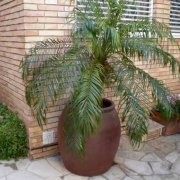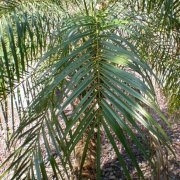Care of the palm tree Phoenix roebelenii or Miniature date palm |
|
The genus Phoenix, family Arecaceae, comprises 11 species of palm trees native to tropical regions of Africa and Asia. Some species are: Phoenix roebelenii, Phoenix reclinata, Phoenix canariensis, Phoenix theophrasti, Phoenix dactylifera. Common names: Miniature date palm, Pygmy date palm. This species is native to Southeast Asia. They are slow-growing palm trees that reach 2 meters (6.56 feet) in height. The graceful leaves are 1.5 meters (4.9 feet) long and have bright green segments 20 cm (7.87") long; the segments near the trunk are sharp. The flowers are small and yellow and appear in panicles 50 cm (19.68") long. They bloom in spring but do not usually do so indoors. The fruit is edible and has a dark drupe shape. Miniature date palm is used as indoor plants in large pots, as isolated specimens and in small groups in gardens with a warm or Mediterranean climate. Phoenix roebelenii needs direct sun or semi-shade exposure. Indoors it is recommended that it receive a few hours of sun. It resists occasional frosts down to -3 ºC (26.6 ºF). The soil must drain well and contain organic matter. The transplant is done in spring; watch out for thorns. Water frequently so that the ground never dries up completely. In summer they are usually watered about 3 times a week if it's very hot. In winter, one watering every 15 days will suffice. Fertilize in spring and summer with houseplant fertilizer every 15-20 days. Prune withered leaves. Phoenix roebelenii is a resistant plant to the usual pests and diseases. Miniature date palm is propagated from seeds sown in the nursery in the fall or spring; it's a slow process because they take more than 3 months to germinate. |
Images of the palm tree Phoenix roebelenii or Miniature date palm |
Find plants
Phoenix roebelenii or Miniature date palm | Care and Growing
© 2026 FavThemes



